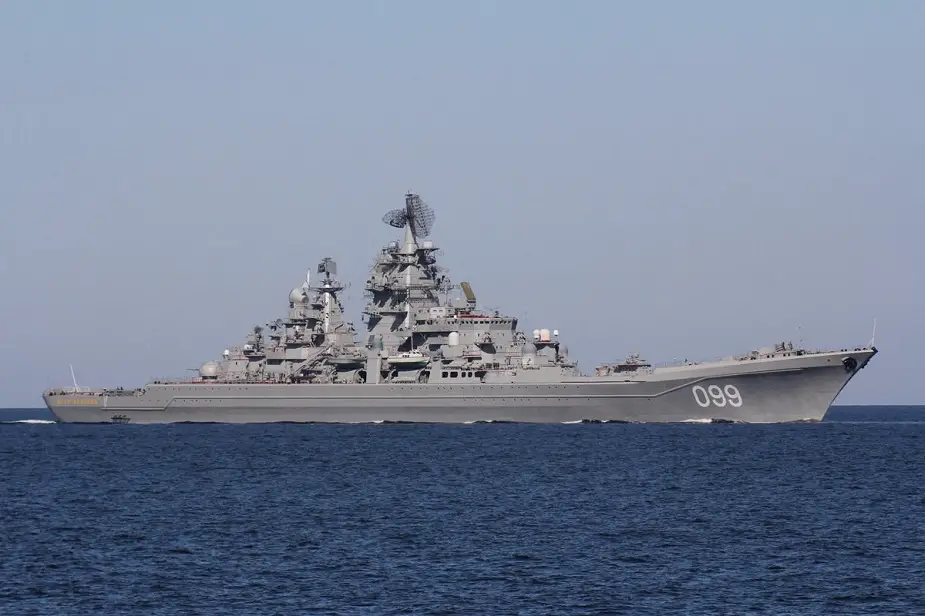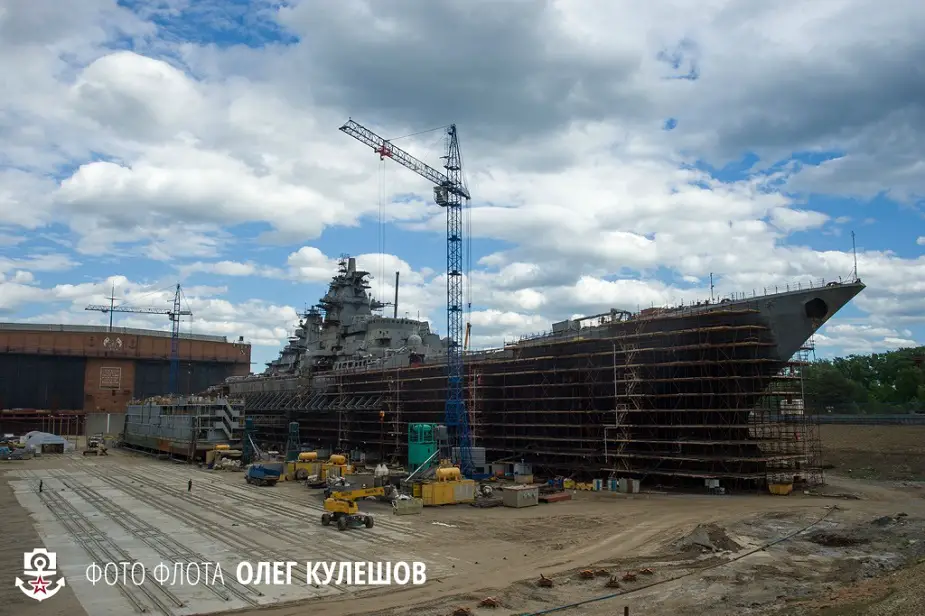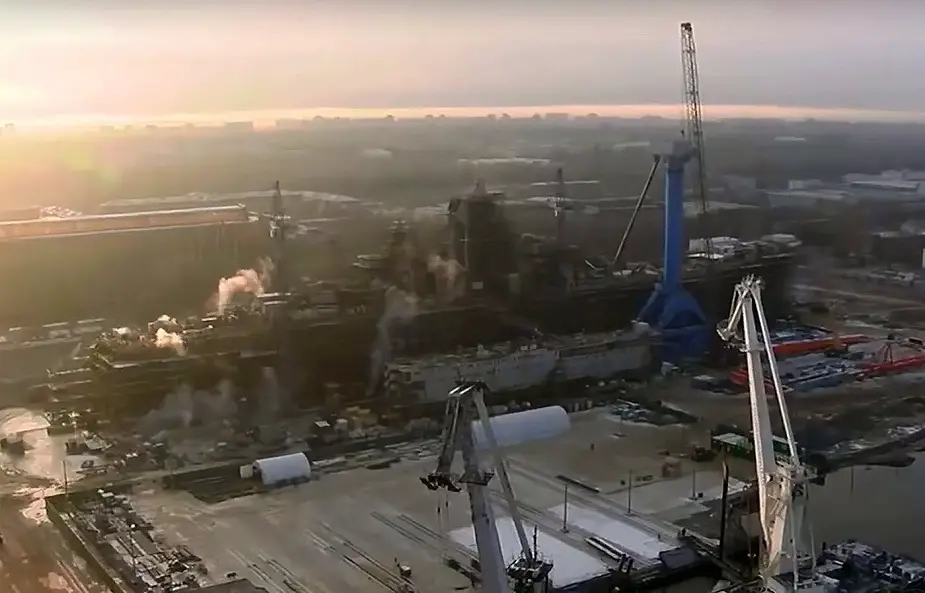Russia continues upgrading its Kirov-class nuclear-powered cruisers
Russia continues to upgrade heavy nuclear cruisers the Admiral Nakhimov and the Petr Veliky of project 1144 to the 11442M level. They will become operational in the 2020s, the Izvestia daily reported.
 The Russian Northern Fleet’s missile cruiser Pyotr Veliky (Kirov-class) on its way to St. Petersburg. Finnish Navy picture.
The Russian Northern Fleet’s missile cruiser Pyotr Veliky (Kirov-class) on its way to St. Petersburg. Finnish Navy picture.
Orlan-class cruisers of project 1144 are a symbol of the Soviet Navy and a good example of protracted design and specification of technical projects. The design of the warships began at the threshold of 1950-60s and the lead cruiser was laid in 1973 and commissioned only in December 1980.
The idea to create a big antisubmarine warfare ship with a nuclear reactor and a displacement of 8000 tons initially broke into two guidelines (nuclear antisubmarine cruiser and nuclear cruiser with antiship weapons) but later merged. The resulting multirole warship with a displacement of over 25 thousand tons which the West still calls a battleship developed into an arsenal of the latest weapons and radio-electronic warfare means while its construction sophistication and costs grew.
The USSR was capable of producing only three cruisers, the lead Kirov (1980), the Frunze (1984) and the Kalinin (1988). Russia inherited the uncompleted Yuri Andropov which it handed over to the navy in 1998 under the name of the Petr Veliky.
The remaining cruisers were renamed into the Admiral Ushakov (in 2004 the name was dropped and the warship renamed nameless with onboard number 090), the Admiral Lazarev and the Admiral Nakhimov.
 Project 11442 heavy nuclear-powered cruiser Admiral Nakhimov is being upgraded to the Project 11442M configuration. 2017 picture.
Project 11442 heavy nuclear-powered cruiser Admiral Nakhimov is being upgraded to the Project 11442M configuration. 2017 picture.
The basic weapons were 20 inclined launchers of antiship Granit missiles with a range of 600 km. Antiaircraft weapons included long-range S-300F Fort and self-defense Osa-M (on the first three cruisers). The Petr Veliky has S-300FM Fort-M instead of S-300F while Osa was replaced by the modern Kinzhal. 30mm AK-630 machineguns on the Kalinin and the Petr were replaced by six antiaircraft close-range Kortik missile-artillery arms. Antisubmarine and radio-electronic weapons changed from one ship to another.
The idea to upgrade project 1144 cruisers has been discussed for long but appropriations were provided only by the state arms program for 2011-2020. The first was the Admiral Nakhimov (former Kalinin) which in 1999 docked at Sevmash shipyard in Severomorsk for repairs and modernization.
It was only in 2013 that the Defense Ministry paid Sevmash for fault detection, repairs and upgrade of the cruiser. In the autumn of the next year the warship was taken to the pool in Severodvinsk for inspection. Initially it was planned to return the cruiser to the navy in 2018 but the deadline was moved to 2021.
The project includes complete rearmament and the Granit will be dropped. In September 2013 then Navy Commander-in-Chief Admiral Viktor Chirkov said the cruiser would receive up to eighty various missiles. It could mean that the Nakhimov would get ten modules for universal 3S-14 complex with eight cells. It can fire long-range 3M-14 cruise missiles, antiship Onix 3M-55 and 3M-54 and antisubmarine missiles. Media reports said it may be armed with hypersonic Tsirkon cruise missiles which are currently undergoing trials. Antiaircraft weapons will include upgraded S-300FM Fort-M similar to the one on the Petr Veliky. The Kortik is likely to be replaced by new Pantsyr-M. Poliment-Redut will also be provided although its installation on the lead Admiral Gorshkov frigate of project 22350 has not been completed so far.
The Petr Veliky will be upgraded in the same way with minor changes in the weapons composition and radio-electronic warfare means. The fate of the Admiral Lazarev (the Frunze) which has been laying up in the Pacific fleet since 1999 is unclear so far. The warship underwent dock maintenance in 2014 "to ensure subdivision at berth". Most likely the fate of the third cruiser will be decided after the upgrade of the Nakhimov is completed and the primary analysis of the Lazarev is made. There has been no official answer so far but it is likely to be negative.
Everything is clear with the fourth warship which is the lead Kirov. It has not been at sea since 1991 (except for towing to Severodvinsk in 1999) and is in a major plight. In 2015 a utilization tender was held and the withdrawal of spent nuclear fuel had to begin.
 Admiral Nakhimov heavy nuclear-powered missile cruiser (TARKR) currently under refit at Sevmash shipyard in Severodvinsk. 2016 Picture: Sevmash shipyard via militaryrussia.ru
Admiral Nakhimov heavy nuclear-powered missile cruiser (TARKR) currently under refit at Sevmash shipyard in Severodvinsk. 2016 Picture: Sevmash shipyard via militaryrussia.ru
The true cost of the Nakhimov upgrade is unknown, but is definitely high. In 2012 Anatoly Shlemov who was in charge of the defense procurement department of the United Shipbuilding Corporation estimated it at 30 bln rubles and 50 bln with new armaments. At that time the estimated construction cost of project 20380 corvette comprised 10 bln rubles, project 11356 frigate - 13 billion, and project 22350 frigate - 18 billion.
These are estimated costs announced before the contract was signed and defect analysis done to determine the real state of the hull, warship systems and cables. Besides, shipbuilding prices began to rapidly rise after 2014-2015 and the cost of some projects upped 60-70 percent. Thus, the rough 80-90 bln ruble estimate of the Nakhimov modernization does not look excessive.
The expensive project causes criticism of experts. The money for the Nakhimov and the Petr can build 5-6 new frigates or a dozen of corvettes. Besides, the navy has a similar project of the same heavy category which it cannot launch so far.

The Russian Navy is called to build the Leader-class project 23560 destroyer or actually a new missile cruiser. There were several options with a displacement of 10-15 thousand tons. Initially two options were proposed: nuclear and gas-turbine, but the former was chosen in the final end. However, the design is not yet over.
The warship has to get the same universal vertical launchers for attack weapons but it is also considered as a carrier of the seaborne perspective S-500 antiaircraft missile system. There were clear statements that warships with antimissile capabilities would appear.
It was planned to build 12 Leaders and share them equally between the Northern and the Pacific fleets. The lead warship was to be laid in 2015 and then in 2017, but the issue subsided after the state arms program for 2011-2020 was revised.
For various reasons the navy did not receive 4.7-5 (by various estimates) trillion rubles initially envisaged by the 2020 arms program. It may be because of industry inability to launch serial production of new warships and up to increased attention to general-purpose forces after the 2014 military-political crisis. As a result, the Ground Forces and Airborne Troops received most of the money, as well as serial hardware procurement. The navy had to complete the failed construction program of frigates and corvettes and had no resources for new projects.
Today the deadline for laying the lead Leader has been moved to 2025 which means the 2018-2027 arms program will not provide major appropriations for it. There were even rumors the Leader had been deleted from the program, but it was later decided to "allocate some money to support the project."
That is why the heavy surface forces of the navy will have to operate the Nakhimov and the Petr Veliky in the 2020s, the Izvestia writes.
© Copyright 2018 TASS. All rights reserved. This material may not be published, broadcast, rewritten or redistributed.


























